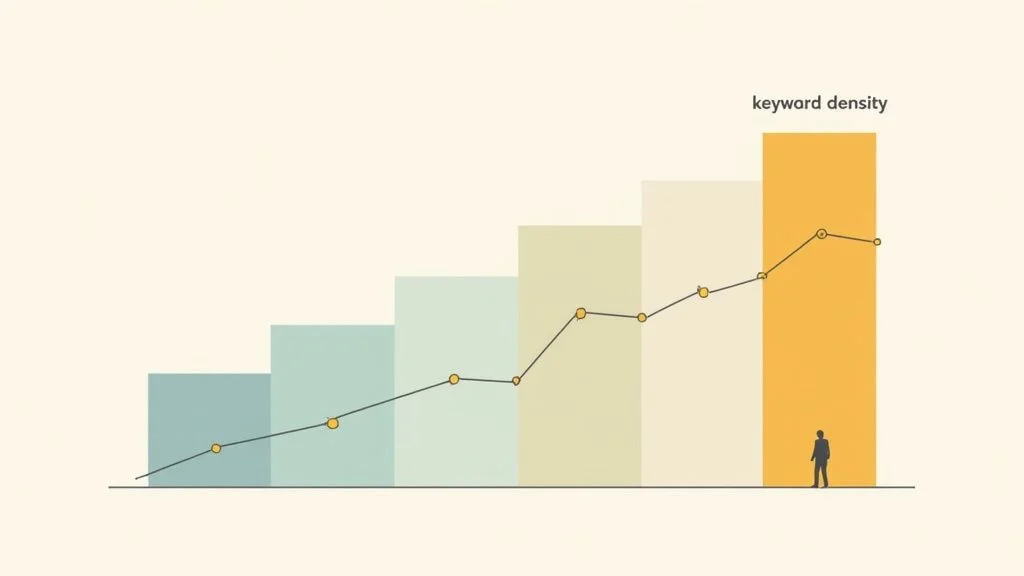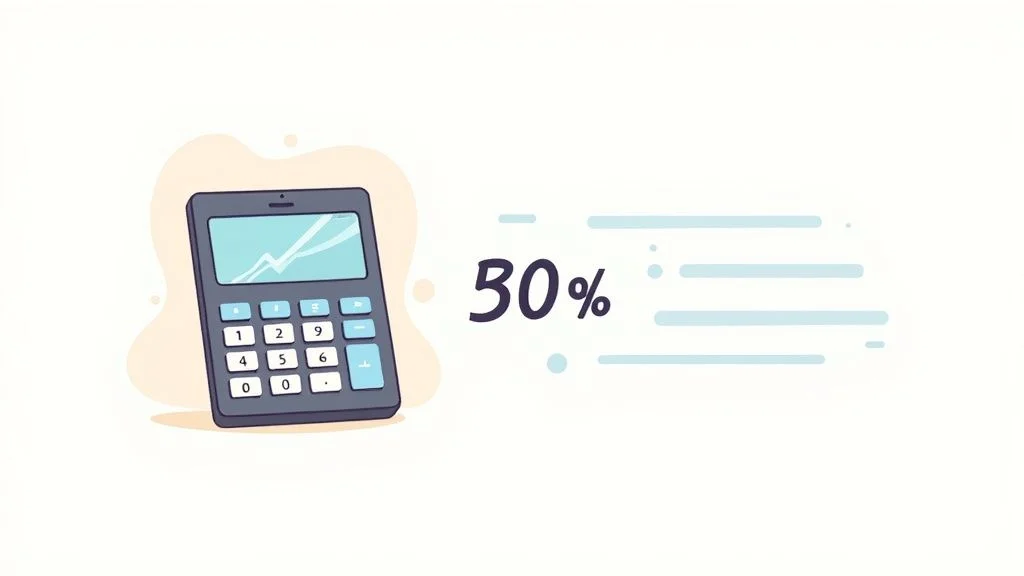
What Is Keyword Density and Why It Matters for SEO
Sections
Back in the day, SEO felt a lot like following a recipe. If you wanted to rank for a certain term, you just had to make sure you used it enough times on the page. That’s the core idea behind keyword density - it’s simply a percentage measuring how often a specific keyword shows up compared to the total word count.
Think of it as a basic check for relevance. It was once a huge deal for search engines.
#So, What Is Keyword Density, Really?

Let’s say you’ve written a fantastic 1,000-word blog post about “organic coffee beans.” If you mention that exact phrase 10 times, your keyword density is 1%. Simple as that. It’s just a raw calculation of how frequently your main topic appears in your text.
In the early, wild-west days of the internet, this was a primary signal for search engines. A high keyword density was a loud and clear message: “Hey, this page is definitely about organic coffee beans!” It was how primitive algorithms figured out what a page was about so they could rank it.
#Why Did This Simple Metric Matter So Much?
The logic was pretty straightforward: the more a page talked about something, the more relevant it must be. This led to a very mechanical, paint-by-numbers approach to writing content, where hitting a specific density percentage was a top priority.
But this simplicity had a massive downside. It created a loophole that people quickly exploited, which ended up changing the entire game of SEO.
For a broader look at how this and other concepts fit into the bigger picture, our glossary of SEO terms is a great resource to have handy.
#Keyword Density At A Glance
To make this super clear, here’s a quick breakdown of the core concepts. This table sums up everything you need to know at a high level.
| Concept | Simple Explanation | Why It Matters |
|---|---|---|
| **Keyword** | The search phrase you want to rank for. | This is the foundation of your content's focus. |
| **Total Word Count** | All the text on your page. | This is the "whole" against which the "part" (your keyword) is measured. |
| **Frequency** | How many times the keyword appears. | This is the raw count used to calculate the density percentage. |
| **Density (%)** | (Frequency / Total Word Count) * 100 | The final metric that shows how prominent your keyword is within the content. |
Understanding these basics is the first step. It helps you appreciate just how much search engines have evolved beyond simple counting.
#Building The Foundational Concept
To truly get it, you just need to remember the three moving parts:
-
The Keyword: This is your target, the phrase you want to be known for.
-
The Total Word Count: The entire text of your article or page.
-
The Frequency: How many times you’ve dropped that exact keyword in.
Keyword density isn’t about chasing a magic number anymore. It’s about making your topic crystal clear. While its direct power over rankings has faded, it’s still a handy gut-check to make sure your content is actually about what you think it’s about - without sounding like a broken record.
Ultimately, knowing where we came from with simple metrics like keyword density is key to understanding where SEO is today, with its focus on context, user intent, and natural language.
#The Rise and Fall of Keyword Density in SEO

Back in the early days of the internet, search engines were pretty simple. Their algorithms weren’t smart enough to figure out what a page was really about, so they relied on basic clues. The most obvious one? How many times a page repeated a specific phrase.
This made keyword density the undisputed king of SEO. If you wanted to rank for “vintage leather jackets,” the game plan was easy: just say “vintage leather jackets” over and over again. The more you repeated it, the more relevant your page looked to those early search crawlers.
Of course, this led to a tactic that’s now infamous in the SEO world: keyword stuffing.
#The Era of Keyword Stuffing
Keyword stuffing was exactly what it sounds like - cramming your target keyword into every possible corner of a webpage. SEOs would load up their articles, meta tags, and even hide words by making them the same color as the background.
The goal was to hit some magic density number, often somewhere between 1-5%. Readability and actually helping the user were thrown out the window. It was a numbers game, and for a short time, it actually worked.
This created a web full of awkward, robotic-sounding content that was great for machines but absolutely terrible for humans. That old “checklist” mindset is precisely why mastering things like modern ecommerce product page SEO today requires a completely different approach.
#The Turning Point for Search Quality
Google quickly realized this was creating a pretty awful experience for everyone. To deliver better results, their algorithms had to evolve. A few game-changing updates came along that completely knocked keyword density off its throne.
-
Google Panda (2011): This update went straight for low-quality, thin content. Pages stuffed with keywords that offered zero real value got hammered, many vanishing from the search results overnight.
-
Google Penguin (2012): Penguin took aim at spammy tactics, including unnatural keyword repetition. It was another massive blow to the “more is better” strategy.
These updates were a clear message from Google: stop trying to trick us. The focus was shifting from simply counting keywords to understanding quality, context, and what the user actually wants.
Later updates like Hummingbird and BERT gave Google an even deeper understanding of natural language, synonyms, and the meaning behind a search.
Today, trying to force a high keyword density is far more likely to get your site penalized than rewarded. It’s a relic of a bygone era. Understanding this history is crucial to grasping why modern SEO is all about creating valuable, user-focused content, not chasing outdated metrics.
#How to Calculate Keyword Density Accurately

Alright, let’s get into the nuts and bolts. Figuring out your keyword density is surprisingly simple. At its heart, it’s just a percentage that tells you how often your target keyword shows up in your content. No need for a supercomputer or a degree in mathematics to get the basic idea.
It’s all about finding a baseline. This classic formula gives you a quick snapshot of your keyword’s frequency, which is a great starting point for analyzing any piece of text.
#The Simple Keyword Density Formula
To calculate it, you just need two numbers: how many times you used your keyword and the total word count of your page. A little division and multiplication, and you’ve got your percentage.
Here’s the go-to formula:
Keyword Density % = (Number of Times Keyword Appears / Total Word Count) x 100
This gives you a straight-up percentage. So, if you wrote a 1,000-word article and used your keyword “indoor plant care” 10 times, your density is 1%. The math is just (10 / 1000) * 100. It’s a handy gut-check to see if you’re on the right track or if you’ve gone overboard.
#Putting the Formula into Practice
Let’s walk through another example to make sure it clicks.
Imagine you’ve just written a 500-word blog post on “sustainable fashion brands.” You do a quick count and see you’ve mentioned that exact phrase 8 times. Now, let’s plug those numbers into the formula:
-
Count Your Keywords: You used “sustainable fashion brands” 8 times.
-
Count Total Words: The article is 500 words long.
-
Divide and Multiply: (8 / 500) x 100 = 1.6%.
Your keyword density comes out to 1.6%. This number itself isn’t magic, but it gives you a solid data point. You can look at it and ask, “Does this feel natural, or am I forcing it?”
#Using SEO Tools for a Smarter Calculation
Now, doing this manually is fine for a single article, but it gets old fast. If you’re analyzing longer content or comparing multiple pages, it’s a real time-sink. Thankfully, modern SEO tools handle this instantly and give you much more context.
-
Yoast SEO: If you’re on WordPress, you probably already know Yoast. It gives you a real-time “keyphrase density” check right in the editor, flagging if your usage is too high or too low.
-
SurferSEO: This tool takes it a step further. Surfer analyzes what’s already ranking on page one and gives you data-backed suggestions for how often to use your main keyword, plus all the important related terms.
These tools don’t just count words for you; they help you understand the bigger picture. They automate the busywork so you can focus on what really matters: creating fantastic content that people and search engines will love.
#The Modern Approach To Keyword Optimization
So, what’s the magic number for keyword density these days? Let’s get straight to it: there isn’t one. The whole game has changed. Modern SEO has moved far beyond obsessing over a perfect percentage. It’s no longer about how many times you can repeat a phrase; it’s about proving you’re a genuine authority on a topic.
If you’re looking for a simple, safe rule of thumb, keeping your main keyword density below 2% is a smart move. This helps you steer clear of any old-school spam filters. But honestly, the real goal isn’t to hit some arbitrary number. It’s to build deep, comprehensive relevance.
Think about it like you’re having a natural conversation. You wouldn’t just repeat the same phrase over and over again, would you? Of course not. You’d use synonyms, bring up related ideas, and find different ways to explain your point. That’s exactly what search engines like Google now expect from your content.
#Beyond Keywords To Concepts
This big shift is all thanks to advancements like semantic search. Search engines don’t just match keywords anymore; they understand the meaning and context behind them. They get synonyms, recognize related people or places, and see how different ideas connect.
This is where focusing on topical relevance really pays off. Instead of just hammering the keyword “what is keyword density,” a truly great article would also dig into:
-
The dangers of keyword stuffing
-
The role of LSI (Latent Semantic Indexing) keywords
-
Tools people use to measure keyword frequency
-
How SEO best practices have evolved over time
When you cover a topic from all these different angles, you send a powerful signal to search engines that your article is the real deal - a complete resource. It’s way more effective than just repeating a keyword. The best way to get started is with a solid plan, which you can build using our guide to keyword research in 30 minutes.
We’ve seen a massive shift away from simple keyword counting toward a much more sophisticated, contextual analysis. It’s worth taking a moment to see just how different the old and new approaches are.
#Old SEO vs Modern SEO Keyword Approaches
This table really breaks down the evolution from the outdated focus on keyword density to the modern, context-first strategy.
| Factor | Old SEO Approach (Keyword Density) | Modern SEO Approach (Topical Relevance) |
|---|---|---|
| **Primary Goal** | Achieve a specific keyword percentage (e.g., 3-5%) | Cover a topic comprehensively and naturally |
| **Keyword Usage** | Repetitive use of the exact-match keyword | Use of primary keywords, synonyms, and related terms |
| **Content Focus** | Centered on a single keyword phrase | Built around a central topic or user query |
| **Algorithm's View** | Sees repetition as a sign of relevance | Understands context, synonyms, and intent |
| **Success Metric** | Keyword density percentage | Topical depth and user engagement |
| **Risk** | High risk of keyword stuffing penalties | Low risk; aligns with user-first principles |
The takeaway here is pretty clear. The old way was a numbers game that was easy to manipulate, while the modern approach is all about creating genuine value for the reader.
#Understanding Advanced Metrics Like TF-IDF
To measure this deeper relevance, the industry has adopted more advanced metrics. One you’ll hear about is TF-IDF (Term Frequency-Inverse Document Frequency). I know, it sounds super technical, but the concept is actually pretty simple. It helps figure out how important a word is to your page compared to a bunch of other pages.
In essence, TF-IDF helps identify terms that are uniquely relevant to your page when compared to other top-ranking pages. This is a much smarter way to analyze content than a simple keyword count.
This evolution is significant. In the early days, pages with a 3-5% keyword density were seen as top-tier. But then came updates like Google’s Hummingbird and BERT, which completely shifted the focus to semantic context. In fact, a 2020 analysis of top-ranking pages revealed that the average exact-match keyword density was just 1.2%. The content that performed best was rich in related terms, not just the primary keyword.
If you’re looking to dive deeper into these strategies, checking out some AI content analysis playbooks can give you a great window into the tools and techniques being used today. The bottom line is simple: focus on creating high-quality, comprehensive content, not just repeating keywords.
#Common Mistakes to Avoid With Keyword Density

Navigating keyword density can feel like walking a tightrope. Lean too far in one direction, and your content falls flat. To create content that ranks well without getting you in trouble with Google or scaring away readers, you first need to understand the common pitfalls.
The most infamous mistake is keyword stuffing. This is an old-school, black-hat tactic where you cram your target keyword into the text over and over again, hoping to manipulate search rankings. It makes your writing sound robotic and clunky, creating a terrible user experience that Google actively penalizes.
#The Problem With Keyword Stuffing
Ever read something like this? “Our best hiking backpack is the best hiking backpack on the market. If you need the best hiking backpack, look no further.” It’s painful to read, totally unhelpful, and screams low-quality.
This approach is the exact opposite of modern SEO, which is all about providing real value. Instead of forcing your keyword, aim for a natural flow by using:
-
Synonyms: Try “top-rated trekking pack” or “quality outdoor bag.”
-
Related Phrases: Weave in concepts like “lightweight trail gear” or “durable rucksacks.”
-
Contextual Language: Talk about features, materials, and situations where someone would use the backpack.
This shows Google you have real expertise on the topic - something simple repetition could never do.
#Forgetting About User Intent
Another huge misstep is obsessing over a specific keyword percentage while completely ignoring user intent. You have to ask: what is the person searching for actually trying to accomplish? Are they looking for information, trying to buy something, or comparing options?
Your number one job should always be to solve the user’s problem. When you focus on giving them the best possible answer, the right keywords and phrases will naturally find their way into your content.
Back in the early 2000s, it was common practice to aim for a 4-6% keyword density. But after Google’s Panda update hit in 2011, that strategy became a one-way ticket to the bottom of the search results. Today, pushing your density over 2-3% is more likely to hurt you than help you, as Google now prioritizes context over simple keyword counts.
#Creating Cannibalization Issues
Finally, a more subtle but equally damaging mistake is targeting the exact same primary keyword across multiple pages on your site. When you do this, you’re forcing your own pages to compete against each other for a spot in the rankings. This dilutes your authority and confuses search engines about which page is the most important one for that search query. To learn more about this self-sabotage, check out our guide on what is keyword cannibalization.
By steering clear of these common mistakes, you shift your mindset from trying to game an algorithm to creating genuinely helpful content. That user-first approach is the real secret to building sustainable, long-term SEO success.
#Common Questions About Keyword Density
Even after you get the hang of keyword density, a few practical questions always seem to pop up. It’s a concept with a lot of old SEO baggage, which naturally leads to some confusion. Let’s clear the air and tackle the most common questions head-on so you can move forward with confidence.
I’ll give you direct, simple answers to help you navigate keyword optimization today, without getting stuck on outdated advice.
#What Is a Good Keyword Density Percentage Today?
This is the big one, but the honest answer is there’s no single magic number. Most SEO pros will tell you that a healthy keyword density stays below 2%. If you push past that, your writing starts to sound robotic and you run the risk of tripping spam filters.
A much better way to think about it is aiming for a range, typically somewhere between 0.5% and 1.5%. This zone is usually the sweet spot where your keyword shows up enough to signal relevance without annoying your reader. But remember, these are just guidelines, not hard-and-fast rules. Your top priority should always be writing natural, readable content that actually helps people.
#Should I Still Track Keyword Density?
Yes, but don’t obsess over it. Think of tracking keyword density as a quick diagnostic check, not a target to hit. It can instantly tell you if you’ve barely mentioned your main topic (a relevance problem) or if you’ve gone overboard and stuffed it in everywhere (a quality problem).
It’s just a quick “gut check” to use during the editing phase. A glance at the percentage can help you spot a potential issue before you hit publish, making sure your content stays focused and sounds human.
Keyword density isn’t a primary ranking factor you need to chase. Instead, think of it as a guardrail that keeps your content on the right path. It helps you steer clear of both under-optimization and over-optimization, making your topic clear to people and search engines alike.
#Does Keyword Density Apply to Different Types of Content?
Absolutely. The core idea is the same across the board, but how you apply it can change a bit depending on the page’s goal.
-
Blog Posts & Articles: For longer, informational content, a lower density is usually best - think 0.5% to 1.5%. The goal here is to cover a topic in-depth with natural language.
-
Product & Landing Pages: These pages are shorter and more to the point. You might see a slightly higher density, maybe closer to 2%, because the keyword is often part of the product name or the core service you’re selling.
-
Homepage Copy: Your homepage has to clearly explain what your business does, so your main keyword will naturally be present. Still, the focus is on a clear message and a great user experience, not hitting a specific percentage.
No matter the format, the golden rule is always the same: put the user first. The writing has to read well and do its job for the person on the other side of the screen.
#How Do LSI Keywords Affect Density?
Latent Semantic Indexing (LSI) keywords - or more simply, related terms and synonyms - are a huge deal for modern SEO. They don’t count toward the density calculation of your main keyword, but using them is far more important than hitting a perfect density score.
Instead of just repeating your primary keyword over and over, you should be weaving in related concepts. This shows search engines that you have a deep, comprehensive understanding of the topic. For an article on “keyword density,” that means you should also be talking about things like:
-
“keyword stuffing penalties”
-
“topical relevance”
-
“natural language processing”
-
“semantic search”
Using these related terms makes your content richer and more helpful. That’s a much more powerful ranking signal than just hammering the same phrase into the page. The real key to a well-optimized article is a healthy mix of your main keyword and plenty of these related ideas. That’s how you create an authoritative piece of content that truly answers a user’s question from all angles.
At Rankdigger, we believe that understanding core SEO concepts is the first step toward building a powerful online presence. Our all-in-one SEO platform provides the tools and insights you need to turn knowledge into action, helping you discover high-potential keywords and optimize your content with confidence. Explore Rankdigger’s powerful features today.

